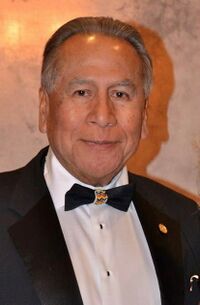High Chief of Utamucanee
| High Chief of Utamucanee | |
|---|---|
| Lukkonopy da Utamvkanee a Hivleanee | |
| Incumbent | |
 | |
| Fenhalloway II | |
| Details | |
| Style | His Majesty |
| Heir apparent | Topalargee, Chackshostimekko da Utamvkanee |
| First monarch | Otvmekko Malatche |
| Formation | c. 1520 CE |
| Residence | Chicuhvtke Palace |
The Monarchy of Utamucanee, officially styled the High Chief of the Utamucaneans (Utamuc: Lukkonopy da Utamvkanee), is a constitutional institution and historic office of the Chiefdom of Utamucanee. The Chiefdom includes all domains of the modern Utamuc nation, though it additionally lays claim to West Hivleanee, currently administered by New Velacruz since seized from the Chiefdom during the Partitioning of the nation in 1876 by New Velacruz, Ovandera, and the Vestric Empire in the Treaty of Costapuente. The Monarchy traces its lineage back to the pre-colonial War-Chiefs of the Utamuc Confederacy, with oral traditions among its modern constituent tribes placing its origins to around the 1400s CE, when the six original Masgo and Sebeno tribes joined together to combat aggression by the Latoa Empire from the South. Originally an oligarchy and later elective monarchy, by the time of contact by the Liedenese in the 1500s, the role had become a hereditary institution, with Otvmekko Malatche, who reigned in the latter half of the 16th Century, being the first of the High Chiefs to be known to Asurans. The High Chief was functionally an absolute monarchy until 1980 following a Coup d'Etat which ensued following the death of High Chief Itta Efhatekka and the following succession crisis. During the First Independent Chiefdom which endured between 1824 and 1876, however, a more rudimentary constitution was codified based on Utamuc common law, which was abandoned in the 1860s during the period of aggression by its neighbors in the leadup to its partitioning, where the High Chief adopted a role more akin to a military dictator steeped in traditional Utamuc culture. The current ruling dynasty is the Clan Alolochatelanits, whose roots are found in the branch of Masgo tribes of the Okahvmkee Governorate.
As a role established by the 3rd Utamucanean Constitution of 1991, the High Chief is the head of state, the ultimate executive authority in the national government, and exercises their authority through royal reserve powers. However, in practice the monarch generally acts as a ceremonial figurehead and is limited by legislation passed in the Diet. The High Chief provides the royal assent, may form and dissolve governments within the constraints of the constitution, appoint the Chancellor and members of their personal Privy Council, and bestow honors, decorations, and rank. Matters of foreign affairs are divided between the High Chief, Chancellor, and Chief-Ambassador. The High Chief additionally has permanent speaking rights in the Diet, and may intervene in certain matters to call immediate voting on legislation where the High Chief may act as a tiebreaker if need be, defined primarily as being causes celebre which enter periods of prolonged political gridlock.
Fenhalloway II is the current High Chief, who ascended to the throne in 2002 following the passing of his father, Pachilusa Malatche. The current heir apparent is his eldest daughter, Chackshostimekko Topalargee.
History
- Further History: List of Utamucanean Monarchs
Pre-Colonial
Absolutism
First Independent Chiefdom
Chiefdom in Exile
Early Second Chiefdom
Post-Issa Reforms
Modern Constitutional Form
Constitutional and Official Role
Privy Council
Succession
Background
Privileges and Restrictions
Residences
Following the implementation of the modern Constitution in 1991, the residences and palaces of the Monarchy became state property. A number remain at the disposal of the high chief; this agreement is revised following each successive monarch ascending to the throne.
Current Residences
Chicuhvtke Palace
The Chicuhvtke Palace, or Little White House, is the primary residence of the Monarch and is their work palace. Built in 1841, the small palace complex was built to replace the First Chiefly Palace in New Braubach, formerly the Palace of the Liedenese Onderkonink prior to the nation's independence, when it suffered major damage in a hurricane earlier in the year. The complex has enough space to host the royal family, its guests, and the requisite offices and meeting spaces require to facilitate the High Cheif's role in the Utamucanean Government.
